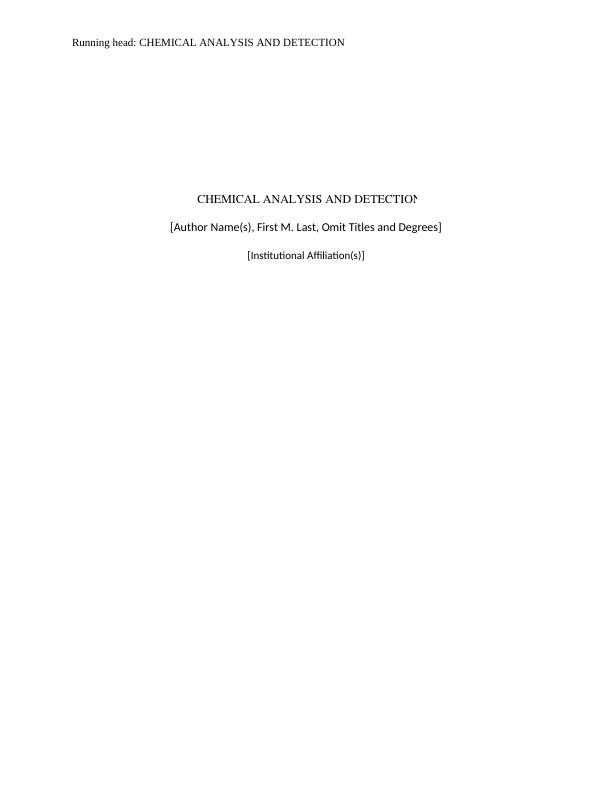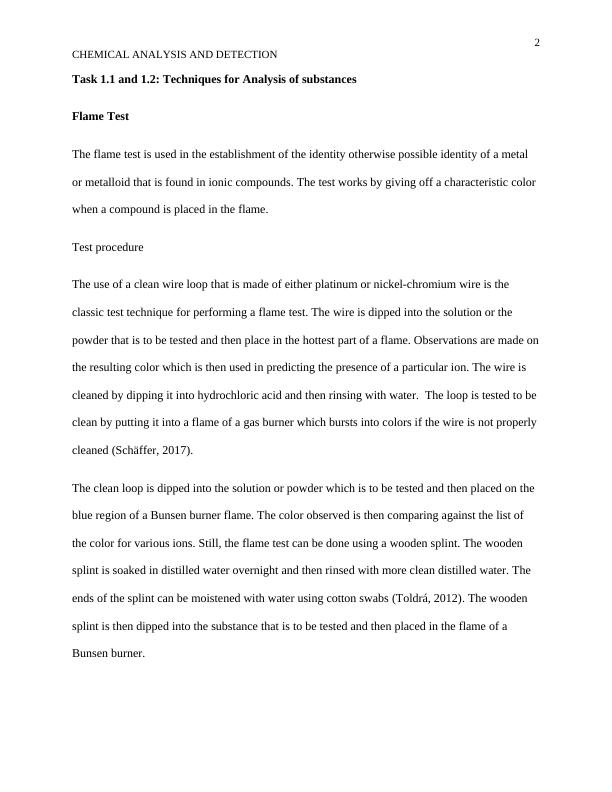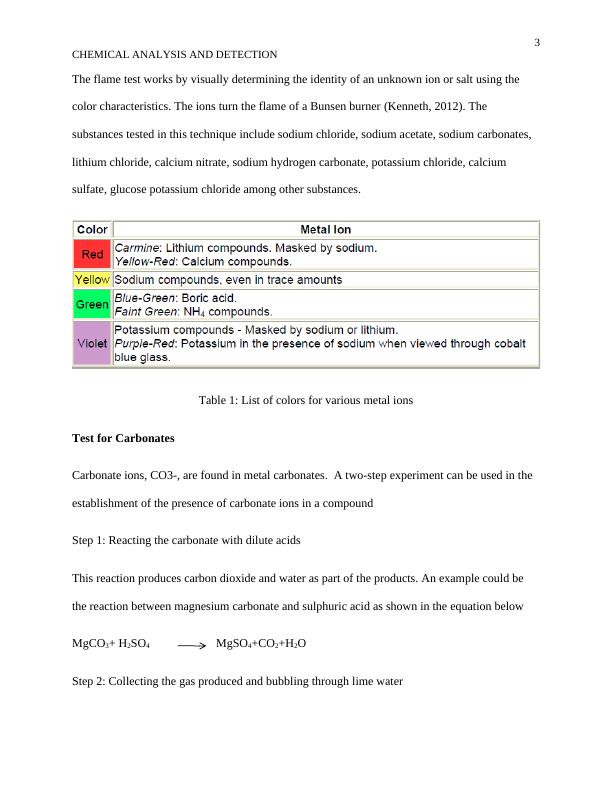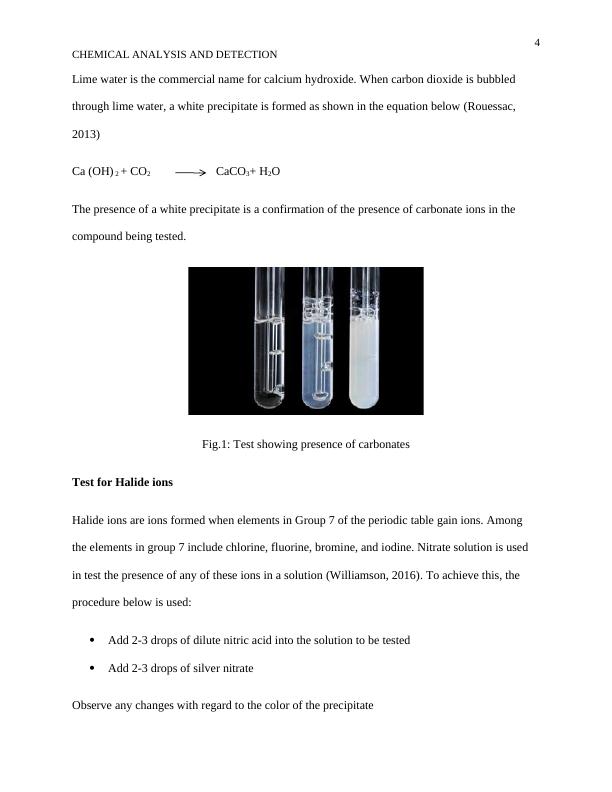Chemical Analysis and Detection: Techniques, Tests, and Identification
Added on 2023-06-13
14 Pages2926 Words358 Views
Running head: CHEMICAL ANALYSIS AND DETECTION
[Author Name(s), First M. Last, Omit Titles and Degrees]
[Institutional Affiliation(s)]
[Author Name(s), First M. Last, Omit Titles and Degrees]
[Institutional Affiliation(s)]

2
CHEMICAL ANALYSIS AND DETECTION
Task 1.1 and 1.2: Techniques for Analysis of substances
Flame Test
The flame test is used in the establishment of the identity otherwise possible identity of a metal
or metalloid that is found in ionic compounds. The test works by giving off a characteristic color
when a compound is placed in the flame.
Test procedure
The use of a clean wire loop that is made of either platinum or nickel-chromium wire is the
classic test technique for performing a flame test. The wire is dipped into the solution or the
powder that is to be tested and then place in the hottest part of a flame. Observations are made on
the resulting color which is then used in predicting the presence of a particular ion. The wire is
cleaned by dipping it into hydrochloric acid and then rinsing with water. The loop is tested to be
clean by putting it into a flame of a gas burner which bursts into colors if the wire is not properly
cleaned (Schäffer, 2017).
The clean loop is dipped into the solution or powder which is to be tested and then placed on the
blue region of a Bunsen burner flame. The color observed is then comparing against the list of
the color for various ions. Still, the flame test can be done using a wooden splint. The wooden
splint is soaked in distilled water overnight and then rinsed with more clean distilled water. The
ends of the splint can be moistened with water using cotton swabs (Toldrá, 2012). The wooden
splint is then dipped into the substance that is to be tested and then placed in the flame of a
Bunsen burner.
CHEMICAL ANALYSIS AND DETECTION
Task 1.1 and 1.2: Techniques for Analysis of substances
Flame Test
The flame test is used in the establishment of the identity otherwise possible identity of a metal
or metalloid that is found in ionic compounds. The test works by giving off a characteristic color
when a compound is placed in the flame.
Test procedure
The use of a clean wire loop that is made of either platinum or nickel-chromium wire is the
classic test technique for performing a flame test. The wire is dipped into the solution or the
powder that is to be tested and then place in the hottest part of a flame. Observations are made on
the resulting color which is then used in predicting the presence of a particular ion. The wire is
cleaned by dipping it into hydrochloric acid and then rinsing with water. The loop is tested to be
clean by putting it into a flame of a gas burner which bursts into colors if the wire is not properly
cleaned (Schäffer, 2017).
The clean loop is dipped into the solution or powder which is to be tested and then placed on the
blue region of a Bunsen burner flame. The color observed is then comparing against the list of
the color for various ions. Still, the flame test can be done using a wooden splint. The wooden
splint is soaked in distilled water overnight and then rinsed with more clean distilled water. The
ends of the splint can be moistened with water using cotton swabs (Toldrá, 2012). The wooden
splint is then dipped into the substance that is to be tested and then placed in the flame of a
Bunsen burner.

3
CHEMICAL ANALYSIS AND DETECTION
The flame test works by visually determining the identity of an unknown ion or salt using the
color characteristics. The ions turn the flame of a Bunsen burner (Kenneth, 2012). The
substances tested in this technique include sodium chloride, sodium acetate, sodium carbonates,
lithium chloride, calcium nitrate, sodium hydrogen carbonate, potassium chloride, calcium
sulfate, glucose potassium chloride among other substances.
Table 1: List of colors for various metal ions
Test for Carbonates
Carbonate ions, CO3-, are found in metal carbonates. A two-step experiment can be used in the
establishment of the presence of carbonate ions in a compound
Step 1: Reacting the carbonate with dilute acids
This reaction produces carbon dioxide and water as part of the products. An example could be
the reaction between magnesium carbonate and sulphuric acid as shown in the equation below
MgCO3+ H2SO4 MgSO4+CO2+H2O
Step 2: Collecting the gas produced and bubbling through lime water
CHEMICAL ANALYSIS AND DETECTION
The flame test works by visually determining the identity of an unknown ion or salt using the
color characteristics. The ions turn the flame of a Bunsen burner (Kenneth, 2012). The
substances tested in this technique include sodium chloride, sodium acetate, sodium carbonates,
lithium chloride, calcium nitrate, sodium hydrogen carbonate, potassium chloride, calcium
sulfate, glucose potassium chloride among other substances.
Table 1: List of colors for various metal ions
Test for Carbonates
Carbonate ions, CO3-, are found in metal carbonates. A two-step experiment can be used in the
establishment of the presence of carbonate ions in a compound
Step 1: Reacting the carbonate with dilute acids
This reaction produces carbon dioxide and water as part of the products. An example could be
the reaction between magnesium carbonate and sulphuric acid as shown in the equation below
MgCO3+ H2SO4 MgSO4+CO2+H2O
Step 2: Collecting the gas produced and bubbling through lime water

4
CHEMICAL ANALYSIS AND DETECTION
Lime water is the commercial name for calcium hydroxide. When carbon dioxide is bubbled
through lime water, a white precipitate is formed as shown in the equation below (Rouessac,
2013)
Ca (OH) 2 + CO2 CaCO3+ H2O
The presence of a white precipitate is a confirmation of the presence of carbonate ions in the
compound being tested.
Fig.1: Test showing presence of carbonates
Test for Halide ions
Halide ions are ions formed when elements in Group 7 of the periodic table gain ions. Among
the elements in group 7 include chlorine, fluorine, bromine, and iodine. Nitrate solution is used
in test the presence of any of these ions in a solution (Williamson, 2016). To achieve this, the
procedure below is used:
Add 2-3 drops of dilute nitric acid into the solution to be tested
Add 2-3 drops of silver nitrate
Observe any changes with regard to the color of the precipitate
CHEMICAL ANALYSIS AND DETECTION
Lime water is the commercial name for calcium hydroxide. When carbon dioxide is bubbled
through lime water, a white precipitate is formed as shown in the equation below (Rouessac,
2013)
Ca (OH) 2 + CO2 CaCO3+ H2O
The presence of a white precipitate is a confirmation of the presence of carbonate ions in the
compound being tested.
Fig.1: Test showing presence of carbonates
Test for Halide ions
Halide ions are ions formed when elements in Group 7 of the periodic table gain ions. Among
the elements in group 7 include chlorine, fluorine, bromine, and iodine. Nitrate solution is used
in test the presence of any of these ions in a solution (Williamson, 2016). To achieve this, the
procedure below is used:
Add 2-3 drops of dilute nitric acid into the solution to be tested
Add 2-3 drops of silver nitrate
Observe any changes with regard to the color of the precipitate

End of preview
Want to access all the pages? Upload your documents or become a member.
Related Documents
Chemistry Experiments: Flame Test, Sulphate Test, Carbonate Test, Nitrate Test, Halide Test, Chromatography, Chemical Identificationlg...
|7
|1438
|352
International Journal of Advanced Research in Chemical Sciencelg...
|8
|1099
|9
REPORT ON THE CHEMISTRY LAB.lg...
|11
|1739
|17
Inorganic contaminants in a water samplelg...
|12
|1808
|32
